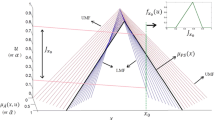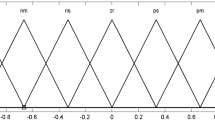Abstract
Primarily the successful implementation of a fuzzy logic system (FLS) depends on some subjective decision-making parameters, for example, membership function (MF). Compared with the input MF, the FLS executes an enhanced output MF to increase the performance, accuracy, and robustness of the FLS. The most suitable relation between input and output MFs is presented to allocate the identical input MFs and enhanced output MFs in the discourse. Various simulations of the 4-Inputs 1-Output FLS are carried out in numerous non-linear processes. Then under similar circumstances, compare the experimental results of identical distribution and enhanced distribution output MFs. Experimental results and simulation results are in a benign contract. Experimental results show that the root mean square error (RMSE) is decreased by about 59.8%, and the relative error is reduced to an acceptable range (≤± 10%). The RMSE is reduced by FLS with enhanced distributed output MFs, which improves control accuracy and improves robustness. In addition, the efficiency of the cost and energy of any FLS will be enhanced by using the most suitable relation of input and output MFs to achieve enhanced distributed output MFs.















Similar content being viewed by others
References
Zadeh LA (1965) Information and control. Fuzzy Sets 8(3):338–353
Khokhar S-U-D, Peng Q, Asif A, Noor MY, Inam A (2020) A simple tuning algorithm of augmented fuzzy membership functions. IEEE Access 8:35805–35814. https://doi.org/10.1109/ACCESS.2020.2974533https://doi.org/10.1109/ACCESS.2020.2974533
Sharma LK, Vishal V, Singh TN (2017) Developing novel models using neural networks and fuzzy systems for the prediction of strength of rocks from key geomechanical properties. Measurement 102:158–169. https://doi.org/10.1016/j.measurement.2017.01.043https://doi.org/10.1016/j.measurement.2017.01.043
Fayaz M, Ullah I, Kim D (2019) An optimized fuzzy logic control model based on a strategy for the learning of membership functions in an indoor environment. Electronics 8(2):132
Noor Y, Peng Q, Khokhar U, Asif A, Abid N, et al (2019) Low cost and energy efficient fuzzy based kitchen ventilation control system. In: 2019 International Conference on Robotics and Automation in Industry (ICRAI). pp 1–6. IEEE
Inam A, Sarwar A, Atta A, Naaseer I, Siddiqui SY, Khan MA et al (2021) Detection of covid-19 enhanced by a deep extreme learning machine
Zhao D, Liu L, Yu F, Heidari AA, Wang M, Oliva D, Muhammad K, Chen H (2021) Ant colony optimization with horizontal and vertical crossover search: fundamental visions for multi-threshold image segmentation. Expert Syst Appl 167:114122
Qazani MRC, Asadi H, Mohamed S, Nahavandi S (2020) Prepositioning of a land vehicle simulation-based motion platform using fuzzy logic and neural network. IEEE Trans Veh Technol 69(10):10446–10456
Hamdia KM, Zhuang X, Rabczuk T (2021) An efficient optimization approach for designing machine learning models based on genetic algorithm. Neural Comput Appl 33(6):1923–1933
Zhang X, Liu H, Tu L (2020) A modified particle swarm optimization for multimodal multi-objective optimization. Eng Appl Artif Intell 95:103905
Daraban S, Petreus D, Morel C (2014) A novel mppt (maximum power point tracking) algorithm based on a modified genetic algorithm specialized on tracking the global maximum power point in photovoltaic systems affected by partial shading. Energy 74:374–388
Seyedmahmoudian M, Horan B, Soon TK, Rahmani R, Oo AMT, Mekhilef S, Stojcevski A (2016) State of the art artificial intelligence-based mppt techniques for mitigating partial shading effects on pv systems–a review. Renew Sust Energ Rev 64:435–455
Farajdadian S, Hosseini SH (2019) Design of an optimal fuzzy controller to obtain maximum power in solar power generation system. Solar Energy 182:161–178
Jeong SK, Han CH, Hua L, Wibowo WK (2018) Systematic design of membership functions for fuzzy logic control of variable speed refrigeration system. Appl Therm Eng 142:303– 310
Tirkolaee EB, Mahdavi I, Esfahani MMS, Weber G-W (2020) A robust green location-allocation-inventory problem to design an urban waste management system under uncertainty. Waste Management 102:340–350
Tirkolaee EB, Abbasian P, Weber G-W (2021) Sustainable fuzzy multi-trip location-routing problem for medical waste management during the covid-19 outbreak. Sci Total Environ 756:143607
Tirkolaee EB, Mardani A, Dashtian Z, Soltani M, Weber G-W (2020) A novel hybrid method using fuzzy decision making and multi-objective programming for sustainable-reliable supplier selection in two-echelon supply chain design. J Clean Prod 250:119517
Wang C (2015) A Study of Membership Functions on Mamdani-type Fuzzy Inference System for Industrial Decision-making. Lehigh University, ???
Ashraf A, Akram M, Sarwar M (2014) Fuzzy decision support system for fertilizer. Neural Comput Appl 25(6):1495–1505
Habib S, Akram M, Ashraf A (2017) Fuzzy climate decision support systems for tomatoes in high tunnels. Int J Fuzzy Syst 19(3):751–775
Alinezhad Esboei A, Karimi Gavareshki M (2021) Using a fuzzy expert system as a decision support system to decrease time consumption in the uast development process: a case study. Iran J Fuzzy Syst 18 (3):27–38
Mathew J, Griffin J, Alamaniotis M, Kanarachos S, Fitzpatrick ME (2018) Prediction of welding residual stresses using machine learning: comparison between neural networks and neuro-fuzzy systems. Appl Soft Comput 70:131–146
SalimAneed H, Sultan KF, Ghafoor MS (2006) Evaluation the performance and implementation of fuzzy logic controller in steam turbine of the thermal power plant
Kartikasari RY, Prakarsa G, Pradeka D (2020) Optimization of traffic light control using fuzzy logic sugeno method. Int J Oper Res 1(2):51–61
Peng Q, Touqir R, Khan MS et al (2020) Medical condition monitoring system using fuzzy logic. In: 2020 IEEE International Conference on Artificial Intelligence and Information Systems (ICAIIS). pp 211–216. IEEE
Hang L, Kim D-H (2018) Enhanced model-based predictive control system based on fuzzy logic for maintaining thermal comfort in iot smart space. Appl Sci 8(7):1031
Cao J-p, Jeong S-K, Jung Y-M (2014) Fuzzy logic controller design with unevenly-distributed membership function for high performance chamber cooling system. J Cent South Univ 21(7):2684–2692
Bezine H, Derbel N, Alimi AM (2002) Fuzzy control of robot manipulators: some issues on design and rule base size reduction. Eng Appl Artif Intell 15(5):401–416
Devarasiddappa D, Chandrasekaran M (2021) Fuzzy logic modelling of sustainable performance measure (mrr) during wedm of ti/6al/4v alloy. Materials Today: Proceedings 46:3373–3378
Tang Y, Yu F, Pedrycz W, Yang X, Wang J, Liu S (2021) Building trend fuzzy granulation based lstm recurrent neural network for long-term time series forecasting. IEEE transactions on fuzzy systems
Ghosh R, Mohanty S, Pattnaik PK (2021) An evolving alpha-dependent mobility model for a fleet of unmanned aerial vehicles in wireless sensor networks. Int J Commun Syst 34(14):4926
Olatunji OO, Akinlabi S, Madushele N, Adedeji PA (2019) Estimation of the elemental composition of biomass using hybrid adaptive neuro-fuzzy inference system. BioEnergy Research 12(3):642–652
Tsai S-B, Xue Y, Zhang J, Chen Q, Liu Y, Zhou J, Dong W (2017) Models for forecasting growth trends in renewable energy. Renew Sust Energ Rev 77:1169–1178
Cosme LB, Caminhas WM, D’Angelo MFSV, Palhares RM (2018) A novel fault-prognostic approach based on interacting multiple model filters and fuzzy systems. IEEE Trans Ind Electron 66(1):519–528
Zhou H, Zhang Y, Duan W, Zhao H (2020) Nonlinear systems modelling based on self-organizing fuzzy neural network with hierarchical pruning scheme. Appl Soft Comput 95:106516
Han H-G, Sun C, Wu X, Yang H, Qiao J (2021) Training fuzzy neural network via multi-objective optimization for nonlinear systems identification. IEEE transactions on fuzzy systems
Lu X, Liu W, Zhou C, Huang M (2017) Robust least-squares support vector machine with minimization of mean and variance of modeling error. IEEE Trans Neural Netw Learn Syst 29(7):2909–2920
Guan T, Han F, Han H (2019) A modified multi-objective particle swarm optimization based on levy flight and double-archive mechanism. IEEE Access 7:183444–183467
Qiao J, Zhou H (2018) Modeling of energy consumption and effluent quality using density peaks-based adaptive fuzzy neural network. IEEE/CAA Journal of Automatica Sinica 5(5):968–976
Acknowledgements
This research work was carried out in the laboratories of the Department of Computer Science and Department of Physics (Electronics), GC University, Lahore, Pakistan. We thank all personnel for their cooperation and participation in facilitating our experiments, especially Dr. Ali Asif and Mr. Muhammad Yasir Noor.
Author information
Authors and Affiliations
Corresponding author
Ethics declarations
Conflict of Interests
The authors declare that there are no conflicts of interest regarding the publication of this article.
Additional information
Publisher’s note
Springer Nature remains neutral with regard to jurisdictional claims in published maps and institutional affiliations.
QinKe Peng contributed equally to this work.
Rights and permissions
About this article
Cite this article
Khokhar, Sud., Peng, Q. Utilizing enhanced membership functions to improve the accuracy of a multi-inputs and single-output fuzzy system. Appl Intell 53, 7818–7832 (2023). https://doi.org/10.1007/s10489-022-03799-4
Accepted:
Published:
Issue Date:
DOI: https://doi.org/10.1007/s10489-022-03799-4




